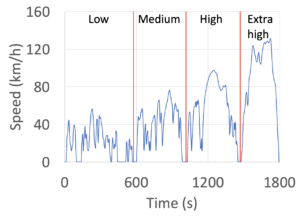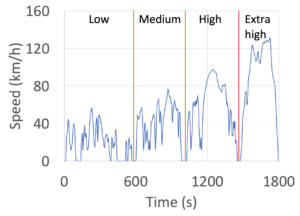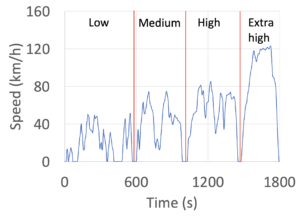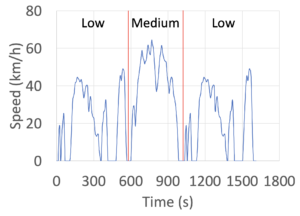Background
At its November 2007 session, the World Forum for Harmonization of Vehicles Regulations (WP.29) of the United Nations Economic Commission for Europe (UNECE) established an informal group under its Working Party on Pollution and Energy (GRPE) to prepare a road map for the development of a Worldwide harmonized Light Vehicles Test Procedure (WLTP). This road map was proposed in 2009 and called for the development of a Global Technical Regulation (GTR) for light-duty vehicles, similar to regulations developed earlier for motorcycles (GTR no. 2, World Motorcycle Test Cycle) and heavy-duty vehicles (GTR no. 4, World-wide harmonized Heavy Duty Certification). A UN GTR specifies globally harmonized performance-related requirements and test procedures, but not the administrative provisions for certification by individual countries and their mutual recognition. Member countries, or “contracting parties,” that adopt the GTR are obliged to incorporate the GTR into their national laws.
In 2013, after four years of work, the first formal text for the WLTP was adopted by the GRPE. The decision was confirmed by the WP.29 in 2014. The WLTP, which is defined by GTR no. 15, was transposed to Regulation (EU) 2017/1151(WLTP 1st act) and amended by (EU) 2018/1832 (WLTP 2nd act). The WLTP replaced the European NEDC procedure for type approval testing of light-duty vehicles.
The development of the WLTP comprised two main elements:
- Development of a harmonized driving cycle representative of world average driving conditions (internally referred to as the DHC)
- Development of a harmonized test procedure that sets the conditions, requirements, tolerances, etc. for the emissions test (internally referred to as the DTP)
The 2018 EU amendment to the WLTP introduced a new evaporative emissions test procedure. The same regulation introduced onboard fuel and energy consumption monitoring (OBFCM) requirements in the EU for all new type approved M1 vehicles starting in January 2020 and for N1 vehicles starting in January 2021, with requirements applying to all vehicles of the respective category one year later.
Harmonized Driving Cycles
Driving cycles are an essential element for the measurement of fuel consumption and emissions. Three different driving cycles were developed and represent three different vehicle classes, based upon a vehicle’s power-to-mass (PMR) ratio and its maximum speed. The PMR parameter is defined as the ratio of rated power (W) / curb mass (kg). The curb mass (or kerb mass in British English) means the “unladed mass” as defined in ECE R83. The cycle definitions may also depend on the maximum speed (v_max) which is the maximum speed of the vehicle as declared by the manufacturer (ECE R68) and not any use restriction or safety-based limitation.
| Category | PMR | Speed phases | Comments |
|---|---|---|---|
| Class 3 | PMR > 34 | Low, Middle, High, Extra-High | If v_max < 135 km/h, phase ‘extra-high’ is replaced by a repetition of phase ‘low.’ |
| Class 2 | 34 ≥ PMR > 22 | Low, Middle, High | If v_max < 90 km/h, phase ‘high’ is replaced by a repetition of phase ‘low.’ |
| Class 1 | PMR ≤ 22 | Low, Middle | If v_max ≥ 70 km/h, phase ‘low’ is repeated after phase ‘middle.’ If v_max < 70 km/h, phase ‘middle’ is replaced by a repetition of phase ‘low.’ |
Class 3 Cycle
With the highest power-to-mass ratio, Class 3 is representative of the types of vehicles driven in Europe and Japan. Selected parameters of the WLTP Class 3 cycle are given in the following table. The vehicle speed and acceleration for the Class 3a vehicles (v_max < 120 km/h) are shown in Figure 1a. The Class 3b cycle (for vehicles with v_max ≥ 120 km/h) is shown in Figure 1b.
| Phase | Duration | Stop duration | Distance | p_stop | v_max | v_ave w/o stops | v_ave w/ stops | a_min | a_max |
|---|---|---|---|---|---|---|---|---|---|
| s | s | m | km/h | km/h | km/h | m/s² | m/s² | ||
| Low | 590 | 145 | 3095 | 24.6% | 56.5 | 25.0 | 18.9 | -1.47 | 1.47 |
| Middle | 433 | 47 | 4756 | 10.9% | 76.6 | 44.4 | 39.5 | -1.49 | 1.57 |
| High | 455 | 29 | 7162 | 6.4% | 97.4 | 60.5 | 56.7 | -1.49 | 1.58 |
| Extra-High | 323 | 6 | 8254 | 1.9% | 131.3 | 93.7 | 92.0 | -1.21 | 1.03 |
| Total | 1801 | 227 | 23266 |
Class 2 Cycle
Class 2 is representative of the types of vehicles driven in India and of low-power vehicles driven in Japan and Europe. Selected parameters of the Class 2 cycle (Version 1.4) are given in the table below, and the vehicle speed and acceleration are shown in Figure 2.
| Phase | Duration | Stop duration | Distance | p_stop | v_max | v_ave w/o stops | v_ave w/ stops | a_min | a_max |
|---|---|---|---|---|---|---|---|---|---|
| s | s | m | km/h | km/h | km/h | m/s² | m/s² | ||
| Low | 589 | 155 | 3132 | 26.3% | 51.4 | 26.0 | 19.1 | -1.07 | 0.92 |
| Middle | 433 | 48 | 4712 | 11.1% | 74.7 | 44.1 | 39.2 | -0.99 | 0.96 |
| High | 455 | 30 | 6820 | 6.6% | 85.2 | 57.8 | 54.0 | -1.11 | 0.85 |
| Total | 1477 | 233 | 14664 |
Class 1 Cycle
With the lowest power-to-mass ratio, Class 1 is representative of the types of vehicles driven in India. Selected parameters of the Class 1 cycle (Version 1.4) are given in Table 2, and the vehicle speed and acceleration are shown in Figure 3.
| Phase | Duration | Stop duration | Distance | p_stop | v_max | v_ave w/o stops | v_ave w/ stops | a_min | a_max |
|---|---|---|---|---|---|---|---|---|---|
| s | s | m | km/h | km/h | km/h | m/s² | m/s² | ||
| Low | 589 | 155 | 3324 | 26.3% | 49.1 | 27.6 | 20.3 | -1.00 | 0.76 |
| Middle | 433 | 48 | 4767 | 11.1% | 64.4 | 44.6 | 39.6 | -0.57 | 0.63 |
| Total | 1022 | 203 | 8091 |
Harmonized Test Procedure
In addition to the driving cycle, a test procedure is needed to prescribe test conditions, requirements, and tolerances. The procedure covers everything from the preparation of the test vehicle and measurement equipment, to how the test is to be conducted and the results calculated.
Since the WLTP was intended to harmonize test procedures worldwide, the GRPE developed a cycle representing typical driving characteristics around the world. This is referred to as the World Harmonized Light-duty Vehicle Test Cycle, or WLTC. The real-world driving data used as input for this development came from five different regions: the European Union plus Switzerland, the United States, India, Korea, and Japan. The WLTC is used to determine pollutant and CO2 emissions.
CO2 emissions are determined for each individual vehicle configuration (rims, tires, special equipment), but not every vehicle configuration can be tested. Therefore, the concept of road load and interpolation families was introduced in 2017. Road load refers to the force resisting the forward motion of the vehicle, i.e., rolling resistance and aerodynamic and inertial forces on the drivetrain. A road load family is a group of vehicles whose individual road load parameters can be determined by linear interpolation between two reference vehicles defining the family. An interpolation family, or CO2 interpolation family, is a group of vehicles whose CO2 emissions are linearly dependent on road load only. Therefore, the CO2 parameters of an individual vehicle in an interpolation family can be determined by linear interpolation using the road load as the interpolation parameter.
While the WLTC is performed at 23°C, the average ambient temperature encountered in the different regions adopting the WLTP likely deviate from this reference temperature. To address the effect of this temperature difference on the CO2 emissions level, an ambient temperature correction test (ATCT) procedure is applied. Similar to the concept of road load and interpolation families, ATCT families are formed to reduce the type-approval testing burden. Per ATCT family, a representative vehicle’s CO2 emissions are measured at 23°C and at the representative ambient temperature. The ratio of CO2 emissions at the two temperatures is used to determine a correction factor that is applied to all vehicles belonging to the ATCT family. Each contracting party can select an individual representative ambient temperature. In the EU, the ATCT test is performed at 14ºC.
Links
Worldwide harmonized Light vehicles Test Procedure, GTR no. 15
Full documentation of Global Technical Regulations
UN ECE GRPE (Working Party on Pollution and Energy)
ICCT Policy Update, World-Harmonized Light-Duty Vehicles Test Procedure, Nov 2013






